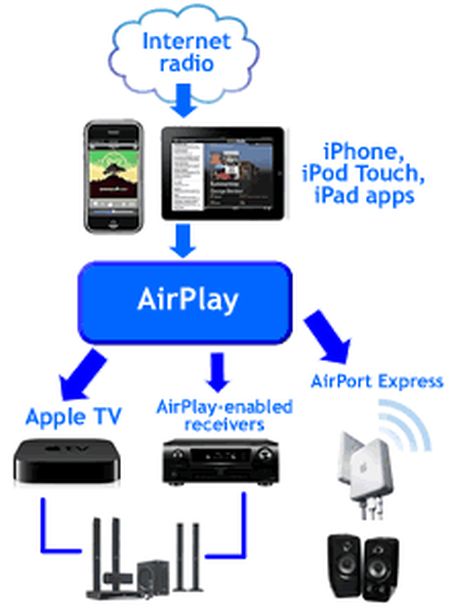How to Connect AirPlay Devices
To send and receive streaming audio and video with AirPlay, the devices you’re using must first be connected to the same local network. This connection could be wireless, using WiFi or Bluetooth, or wired, using Ethernet. Though connecting with Bluetooth isn’t the same as being on your home computer network, AirPlay detects Bluetooth devices automatically and lets you manage them alongside your other network-accessible AirPlay options.
For WiFi networks there are two ways you can set up your AirPlay network connections:
- You can use an Apple AirPort Express, a small portable wireless router designed to interconnect all your Apple devices whether or not you have an Internet connection. AirPort needs no additional equipment or setup in order to use AirPlay, and you can connect a stereo directly to the AirPort to use as either the source or receiver for an AirPlay audio stream.
- Without AirPort Express, you can use an existing home network setup, such as a wireless router. If you already use a router to share a single Internet service among multiple computers in your home, then all you need to do is connect each AirPlay-enabled device to that same network. For more about setting up your home network, see our article How Home Networking Works.
After you’ve added your AirPlay-enabled devices to the same network, each AirPlay source can automatically detect all its potential receivers. For example, if you add your iPad to the network, the iTunes app on your iPad will automatically detect that the Apple TV in your living room and the AirPlay-enabled speakers in your bedroom are possible remote output devices.
So how do you use it? Airplay-enabled apps will automatically scan your WiFi network for compatible devices. When an application detects that AirPlay is possible, the AirPlay icon will appear in the application display. Once you access the AirPlay menu, you can select individual devices you want to receive the streaming audio or video from that application. Note that if you wish to share your media between two computers on your network, the AirPlay icon will not appear. That’s because the iTunes application for desktop and laptop computers already has a built-in library sharing function for other iTunes users on your network. AirPlay is redundant for this computer-only scenario. For more information on streaming, check out our article on How Streaming Video and Audio Works.
The Pros and Cons of Apple AirPlay
Some tech experts tout AirPlay as a revolutionary technology that will change the face of home entertainment and network data sharing. AirPlay has the following advantages that give credence to that idea:
- There continues to be an increasing number of Apple iOS apps (for iPad, iPhone and the iPod touch) that support streaming output using AirPlay.
- When used with Apple TV, your Apple mobile device becomes a hand-held remote control for sharing music, movies and photos on your TV.
- Even while streaming content from it, you can keep using your Apple mobile device for other things like checking e-mail, updating your Facebook status or playing “Angry Birds.”
- Audio streams carry track information, including artist and song title, which the receiver can show on its own graphical display.
- When you’ve enabled AirPlay on each of your devices, the system works without any complicated configuring.
- If the source you’re playing from is streaming HD video, AirPlay can carry that HD quality to your Apple TV (version 2 or later).
Despite these great features, AirPlay also has its limitations. Most of the criticism around AirPlay cites the following disadvantages:
For more detail: How Apple AirPlay Works

